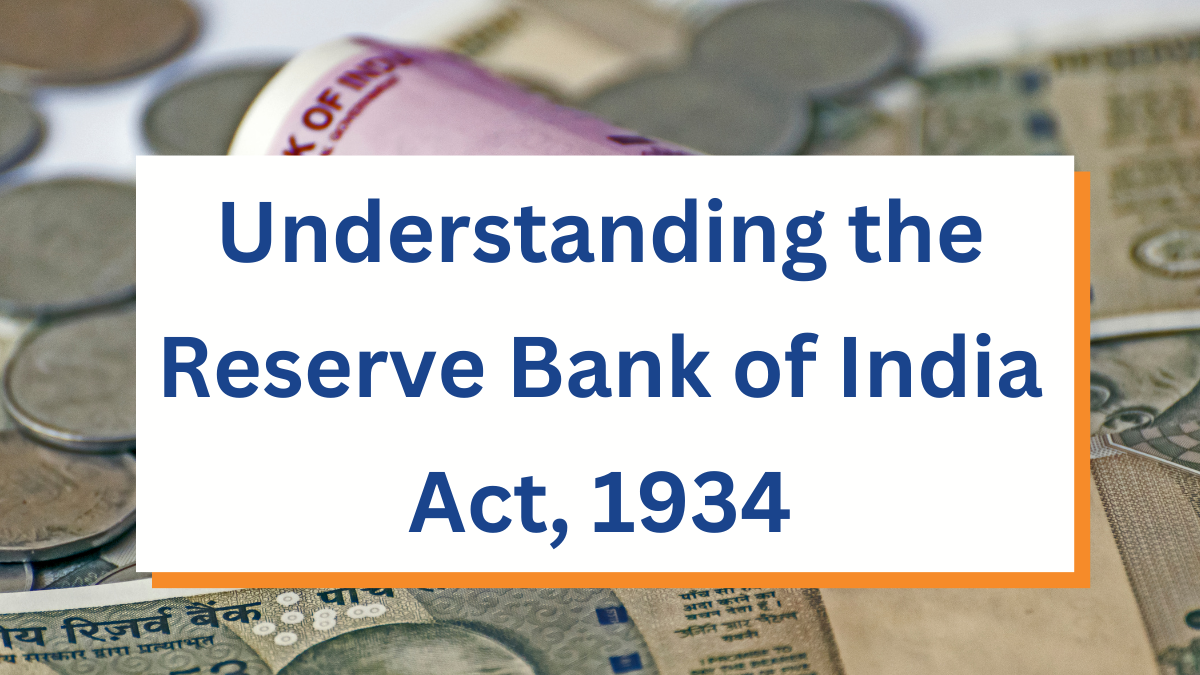In this blog, come let us find some answers for questions like ‘How important is the Reserve Bank of India to our nation’s economy?’ ‘Why and when was it formed?’
The Reserve Bank of India (RBI) came into existence in 1935 through the Reserve Bank of India Act of 1934. It’s headquarters is located in Mumbai. RBI functions as per the guidelines explained under this Act.
The RBI checks the flow of money within the country and also the operations of other banks in India. Certain important aspects like Indian rupee’s value compared to other currencies, inflation, interest rates, etc., are managed by RBI. It uses various methods to improve situations, working behind the scenes to keep India’s financial system balanced and stable.
Now let’s discuss further about the important aspects of this act and its significance.

Historical Background
The Royal Commission in 1926 had suggested in creating a Central Bank to oversee and regulate India’s financial system, which eventually led to the formation of the RBI Bill, 1933. This Bill was passed in the Parliament with the then Governor’s assent as the Reserve Bank of India Act in 1934. In 1935 RBI commenced its business with a capital of ₹ 5 Crore.
The Act provides legal framework for RBI to effectively function as the nation’s central bank to uphold the economic stability. This was a significant milestone in India’s economic history.
Objectives of the Act
- The primary objective of the Reserve Bank of India Act is to ensure the stability and regulation of the Indian monetary and financial systems.
- The duty to issue currency notes, hold reserves, and manage the country’s foreign exchange is one of the key banking functions of RBI under this Act.
- It provides a legal framework for the functioning of the RBI and outlines its roles, functions, and powers.
- RBI also became responsible for the supervision and regulation of commercial banks and other financial institutions operating in India, under the Banking Regulation Act ,1949
- Another critical function of RBI is to supervise and regulate non-banking financial companies (NBFCs) operating in India.
Structure and Provisions
The Reserve Bank of India Act, 1934 is divided into several sections, with each section dealing with a specific aspect of the RBI’s operations. Some of the key provisions of the act are:
Establishment and Incorporation of the RBI
Section 3 of the act establishes the RBI as a body corporate with perpetual succession and a common seal. It outlines the management structure of the RBI, including the appointment of a Governor and Deputy Governors. This section also specifies that the central government shall hold shares of the RBI’s capital.
Functions and Responsibilities
The act defines the functions and responsibilities of the RBI in Section 17. These include controlling the issue of banknotes, regulating the banking and credit system, managing foreign exchange reserves, and acting as a banker to the government. The RBI is also responsible for formulating and implementing monetary policy to maintain price stability and promote economic growth.
Powers and Autonomy
The Reserve Bank of India Act grants significant powers and autonomy to the RBI. Section 7 of the act empowers the Central Government to give directions to the RBI in public interest, but the RBI has the authority to refuse to comply if it deems such directions detrimental to the interests of the economy. This provision ensures the RBI’s independence in decision-making.
Reserve Fund and Surplus
Section 46 of the act establishes the Reserve Fund of the RBI, which is built from the profits earned by the bank. The RBI is required to transfer a certain percentage of its net profits to this fund. Section 47 deals with the distribution of surplus profits to the central government after making provisions for the Reserve Fund and other contingencies.
Significance of the Act
The Reserve Bank of India Act, 1934 is significant for multiple reasons:
- Economic Stability: The act serves as the cornerstone of India’s financial stability by providing a robust legal framework for the functioning of the RBI. It enables the RBI to maintain price stability, regulate the banking system, and manage foreign exchange, ensuring a stable economic environment.
- Central Bank Independence: The act establishes the independence of the RBI from undue government interference. This independence enables the RBI to make crucial monetary policy decisions in an unbiased manner, without political pressure, promoting financial stability and economic growth.
- Banking Sector Regulation: The act empowers the RBI to regulate and supervise the banking system in India. It ensures the safety and soundness of banks, protects depositors, and promotes transparency and accountability in the banking sector.
- Monetary Policy Implementation: The act provides a legal framework for the formulation and implementation of monetary policy by the RBI. Through various tools and instruments, the RBI influences the money supply, interest rates, and credit availability to achieve macroeconomic objectives such as inflation control and economic growth.
- Crisis Management: The act equips the RBI with necessary powers and tools to manage financial crises or systemic risks. It enables the RBI to intervene in the banking sector, restructure distressed institutions, and take measures to maintain financial stability during turbulent times.
Conclusion
The Reserve Bank of India Act, 1934 is an important law that guides how the RBI operates. The Act also defines the rules that apply, including the consequences and legal actions, for not following them. It outlines the RBI’s power to impose penalties, issue directives, and take legal measures against entities that violate the Act or fail to adhere to the RBI’s regulations. Knowing about this act is key to understanding how the RBI functions and its importance in India’s economy.















